Mechanical Pressure Sensors(II)
The Bourdon Tube:
Bourdon tubes are circular-shaped tubes with oval cross sections. The Bourdon tube works on a simple principle that a bent tube will change its shape when exposed to variations of internal and external pressure. As pressure is applied internally, the tube straightens and returns to its original form when the pressure is released.
The tip of the tube moves with the internal pressure change and is easily converted with a pointer onto a scale. A connector link is used to transfer the tip movement to the geared movement sector. The pointer is rotated through a toothed pinion by the geared sector. The bourdon tube mechanism of pressure sensing is shown below:
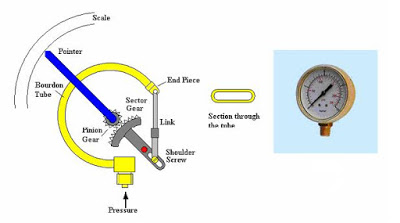
The main advantage with the Bourdon tube is that it has a wide operating range (depending on the tube material). This type of pressure measurement can be used for positive or negative pressure ranges, although the accuracy is impaired when in a vacuum.
Bourdon tube gauges are the most popular in any process plant. Some advantages of bourdon tube gauges are:
I. Direct pressure measurement
II. Fast response
III. Inexpensive
IV. Wide operating range
V. Good sensitivity
They however suffer from the following disadvantages:
I. Limited life when subject to shock and vibration
II. Primarily intended for indication only
III. Non-linear transducer, linearized by gear mechanism
IV. Hysteresis on cycling
V. Sensitive to temperature variations
Helix and Spiral tubes:
Each provides greater tip travel for a given pressure application. With one end sealed, the pressure exerted on the tube causes the tube to straighten out. The amount of straightening or uncoiling is determined by the pressure applied. These two approaches use the Bourdon principle. The uncoiling part of the tube is mechanically linked to a pointer, which indicates the applied pressure on a scale.
The Spiral tube is suitable for pressure ranges up to 30,000 kPa and the helical tube for ranges up to 500,000 kPa. The pressure sensing elements vary depending on the range of operating pressure and type of process involved. Helical and spiral elements in helical and spiral tubes gauge elements are shown below:
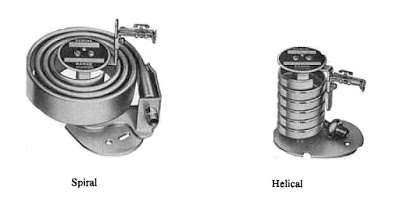
Bellows and capsules:
A bellows is made of several capsules. The capsule consists of two circular shaped, convoluted membranes (usually stainless steel) sealed tight around the circumference. Bellows type elements are constructed of tubular membranes that are convoluted around the circumference (see diagram below). The membrane is attached at one end to the source and at the other end to an indicating device or instrument. The bellows element can provide a long range of motion (stroke) in the direction of the arrow when pressure is applied. Bellows and single capsules are used in many instruments. They are very useful for measuring small pressures.
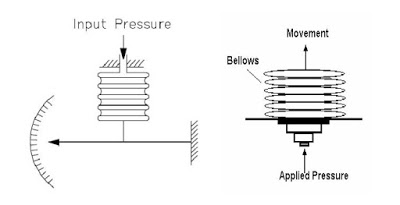
Diaphragms:
Many pressure sensors depend on the deflection of a diaphragm for measurement. The diaphragm is a flexible disc, which can be either flat or with concentric corrugations and is made from sheet metal with high tolerance dimensions. The diaphragm can be used as a means of isolating the process fluids, or for high-pressure applications. It is also useful in providing pressure measurement with electrical transducers.
Diaphragms are well developed and proven. Modern designs have negligible hysteresis, friction and calibration problems when used with smart instrumentation. They are used extensively on air conditioning plants and for ON/OFF switching applications. Shown below is schematic diagram of a diaphragm pressure sensor system:
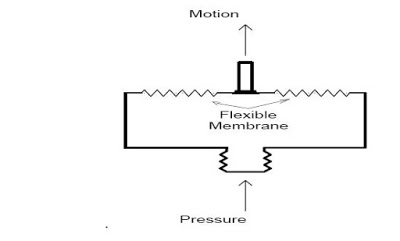
Spring and piston:
Here the pressure acts directly on the piston and compresses the spring. The position of the piston is directly related to the pressure. A window in the outer case allows the pressure to be indicated. This type is usually used in hydraulics where the ability to withstand shock, vibration and sudden pressure changes is needed (shock proof gauge).
The piston movement may be connected to a secondary device to convert its movement into an electrical signal. A piston/spring pressure sensor mechanism is shown below:
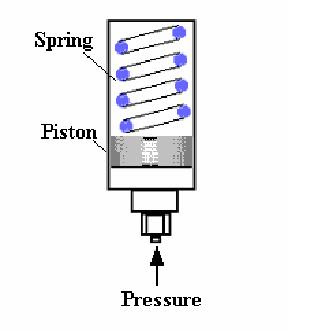
- Pre:How Do Different Types of Level Measurement Devices Work ? 2016/4/14
- Next:India Exhibition-2013 2013/8/9
